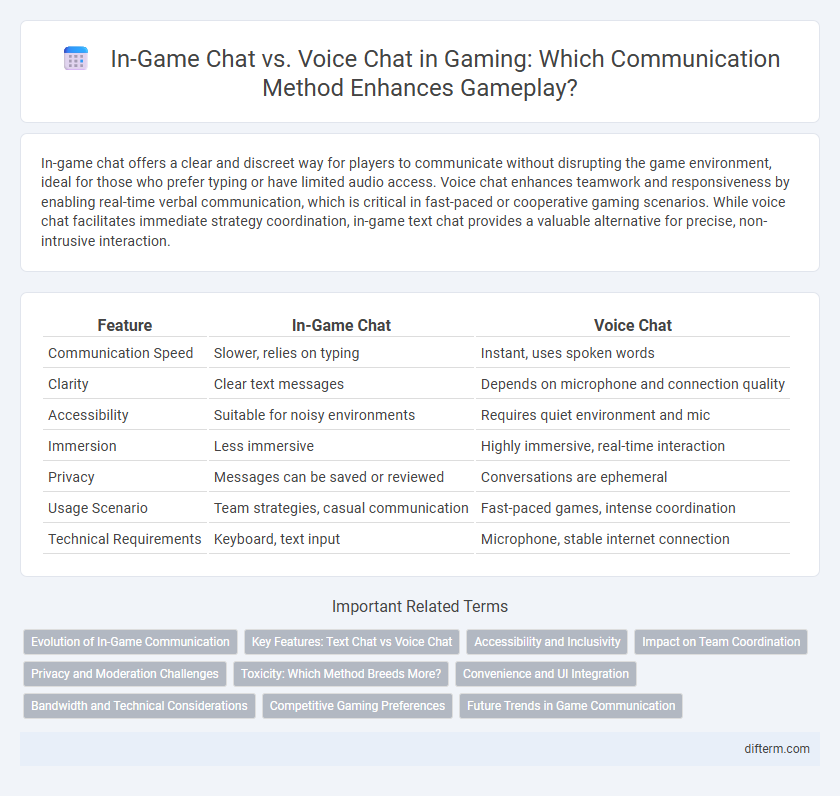In-game chat offers a clear and discreet way for players to communicate without disrupting the game environment, ideal for those who prefer typing or have limited audio access. Voice chat enhances teamwork and responsiveness by enabling real-time verbal communication, which is critical in fast-paced or cooperative gaming scenarios. While voice chat facilitates immediate strategy coordination, in-game text chat provides a valuable alternative for precise, non-intrusive interaction.
Table of Comparison
| Feature | In-Game Chat | Voice Chat |
|---|---|---|
| Communication Speed | Slower, relies on typing | Instant, uses spoken words |
| Clarity | Clear text messages | Depends on microphone and connection quality |
| Accessibility | Suitable for noisy environments | Requires quiet environment and mic |
| Immersion | Less immersive | Highly immersive, real-time interaction |
| Privacy | Messages can be saved or reviewed | Conversations are ephemeral |
| Usage Scenario | Team strategies, casual communication | Fast-paced games, intense coordination |
| Technical Requirements | Keyboard, text input | Microphone, stable internet connection |
Evolution of In-Game Communication
In-game chat has evolved from simple text boxes to sophisticated messaging systems supporting emojis, quick commands, and multiplayer coordination, enhancing player interaction and strategy. Voice chat introduced real-time communication, drastically improving teamwork, immersion, and responsiveness in competitive gaming. The ongoing integration of AI-powered transcription and moderation tools continues to refine both text and voice channels, ensuring clearer, safer, and more inclusive player communication.
Key Features: Text Chat vs Voice Chat
In-game text chat offers players discreet communication through typed messages, enabling strategic planning without disrupting audio cues. Voice chat provides real-time interaction with clear, immediate responses, enhancing teamwork and coordination especially in fast-paced gameplay. Both features support player engagement but differ in accessibility, with text chat favoring quiet environments and voice chat excelling in dynamic, immersive experiences.
Accessibility and Inclusivity
In-game chat enhances accessibility by providing text communication options for players with hearing impairments or those in noisy environments, fostering inclusivity for diverse gamer needs. Voice chat enables real-time collaboration and emotional expression, but may exclude players with speech difficulties or language barriers. Integrating both chat modes with customizable settings ensures a more inclusive gaming experience accommodating varying accessibility requirements.
Impact on Team Coordination
In-game chat provides players with a clear, text-based method to communicate tactics without disrupting gameplay, ensuring messages are documented and accessible during fast-paced sessions. Voice chat enables real-time, dynamic coordination, allowing teams to react instantly to evolving situations and enhance teamwork efficiency. Combining both systems can optimize team coordination by catering to different communication preferences and minimizing misunderstandings.
Privacy and Moderation Challenges
In-game chat and voice chat pose distinct privacy and moderation challenges, with text-based chat enabling easier monitoring but increased risk of data interception, while voice chat struggles with real-time filtering and detecting harmful language. Moderators often face difficulties enforcing rules in voice chat due to the spontaneous and untranscribed nature of conversations, leading to potential abuse and harassment slipping through. Implementing AI-driven tools and robust reporting systems is crucial to balance user privacy with effective content moderation in gaming communication platforms.
Toxicity: Which Method Breeds More?
In-game text chat tends to breed more toxicity compared to voice chat due to the anonymity and time players have to craft hostile messages without immediate social cues. Voice chat, while prone to toxic behavior, often limits this through real-time interaction and social accountability, making players more cautious. Studies show that text-based communication in games correlates with higher rates of verbal abuse, harassment, and griefing incidents than voice-based interactions.
Convenience and UI Integration
In-game chat offers seamless UI integration, allowing players to send messages without interrupting gameplay, enhancing convenience for quick communication. Voice chat provides real-time interaction but can be intrusive if UI elements clutter the screen or require additional setup. Optimizing the balance between unobtrusive chat windows and intuitive voice controls is crucial for maintaining immersion and efficient team coordination.
Bandwidth and Technical Considerations
In-game chat typically requires lower bandwidth compared to voice chat, making it more suitable for players with limited internet speeds or data caps. Voice chat demands continuous, real-time audio streaming, which can increase latency and bandwidth usage, potentially affecting game performance. Technical considerations such as codec efficiency, server infrastructure, and network stability play crucial roles in optimizing both chat types for seamless multiplayer experiences.
Competitive Gaming Preferences
Competitive gamers often prefer voice chat over in-game text chat due to its real-time communication capabilities, which enable faster coordination and strategic responsiveness during high-pressure matches. Voice chat enhances team synergy by allowing immediate feedback and nuanced tone that text chat cannot convey, reducing miscommunication in fast-paced environments. While in-game chat remains useful for non-urgent messages or replay analysis, voice communication is essential for peak performance in esports and competitive gaming tournaments.
Future Trends in Game Communication
Future trends in game communication emphasize the integration of AI-driven voice modulation and real-time language translation, enhancing inclusivity and immersion during in-game chat and voice chat interactions. Developers are increasingly prioritizing low-latency, high-fidelity audio technologies to ensure seamless voice communication across multiplayer platforms. Enhanced data analytics are being utilized to personalize chat experiences, adapting to player preferences and social dynamics in evolving gaming environments.
in-game chat vs voice chat Infographic

 difterm.com
difterm.com